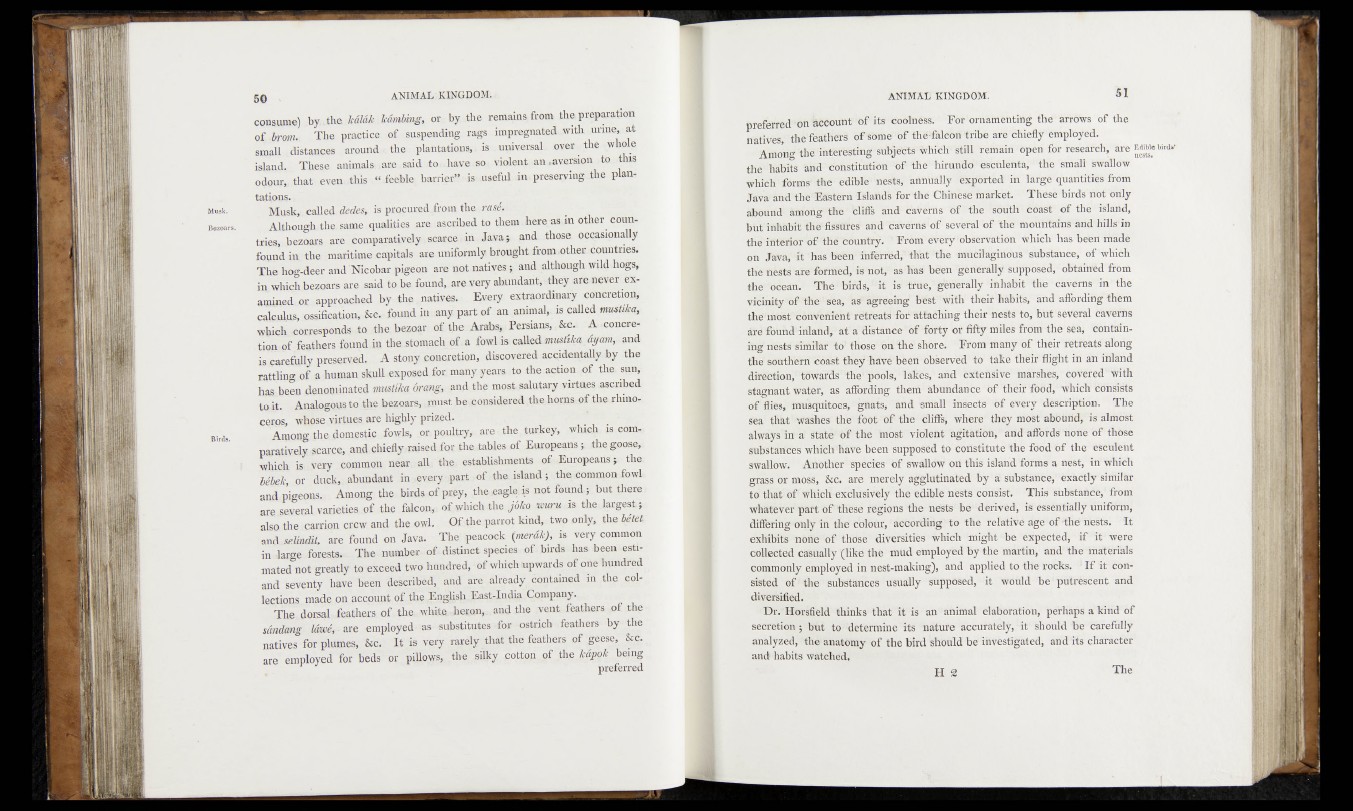
consume) hy, ^M U kU m b in g , ori;by-3tho. remains; from i te preparation
o i brom.. The practice, ,ofr. suspending. rags impregnated^with^urmi^s*
smil distances . armmdu the plantations,, is . universal.. over the -whole
island* These animals .ane.said .to «.have urn* violent,.an .aversion >to . this
odour,, that even*»this ,“ «feeble, barrierfS-ia^useful-in.preserving -the phm*
talons.;
Musk. Mysk, called dedes* is procured from the.rase. .
Bezoars. Although,the. same qualities are ascribed to them, her e/asun other conn*
tries, bezoars are comparatively. scarce. «in. Java; and. those occasionally,
found in. the :maritime capitals are uniformly brought from «others countries.
The hog-deer and Nicobar pigeon are not natives $ and although wild .hogs,
in which bezoars are said tp.be, found, , are very abundant, “they aremever-Jx-
amined, br..apgrpafihed extraordioaiiy ephcration,
calculus, .ossificarion»' §£©•? fowhd m anyipart o f an animal^is called mustika>
which correspondsao .the, bezoar o f the Arabs,; Persians,. &c«; A «concretion
pf feathers found,in the.stomachof a fowl is. called mmtika,. ayavn^ and
is carefully .preserved, A stony concretion, discovered accidentally .by .the
ratthng of ,.nhuman shntt#kppssdj)t many yearntto theraetiom# thn p § p
ha^ been denominated ^lustika arang, and the most.salutary virtues .ascribed
to#. AnaiogQSstpifte be?oars,:must.be^onsid^ed#,%hpmst«ftheljj:hmQr,
ceros, whose virtues, are highly prized. ' f
H Among;,the .domestic, .fowls, or poultry*. are -Ahe, turkey, which is com,;
payativiy-scarge, and.chiefly,-msed-for thejnhles .of Ewopeans Jfet goose,«
which is. very common near all the., establishments ^ E u r o p e a n s th e
beieJc, or duck,, .abundant in ,.every vpart^df the,island ; .the «.common .fowl.
an(j.pigeons- Among the birds of prey, .the eagle ts not found,/but there
are several varieties.,pf ;the falcorv: ofcwhich-the jo&a .'wurv is theJaigesfc;
crew and the owl. two g j g the ^ fe4
and-^UndU, are found on Java. The «peacock (merdk), is very-common
in large TomsJs^ .Th® number-of. distinct species ««pf-birds ha s b e e n - ^ r
mated not greatly- to exceed two hundred/of which upwards o f one hundred
and seventy have'been described, and are- already contained in, ,the (collections
made on account of..tbe English East-Indi^. Company-
The dorsal -feathers of . the«,white.-!he«m,. and the «vent, feathers, ,of ,the
sdndang Idwe, a r e employed^as- eubstitutesdor •ostrkh'.feafchers by -the
natives for plumes, &c, T tis very rarely that the feathers of geese, &c.
are employed for beds or pillows, .the ..silky cottpn^f the Jfyiolc being
preferred
preferied*öh4 ccouttf ’bffits1 coóln&s. -For’ornamenting the?* arrows ‘ of the
natives,•’thè'féith'ërs ó?Tdifte°bf th'ëffaleóiHribe are(chiefly°émptoyed.
Among‘thêffnfétmin^s,tè)^m^hibT?¥ü,ll remain-opèn for research, are S f * * -
thé’’habits and'‘Constitution Jbf thé,‘hirunlo,J1èsfchlënta, ’ the small swallow
which' forms’-the- edible'-'desfef ahifttëlly -Exported •ih°'largdl’'quan titles from
Java4nd'i:h'e!EMèrn Islands Fordhë Chinl^ë-laarkiet. Thésè birds hot orily
abound among the' hliffs and fchverns -df hthe ^sbu'thJ éühst' of th e 1 island,
bhVi’n'habit tH^fisMès’ and 'cavérns'óf sevefaFóf thé-mountains and hills'in
th'diÏÏtërior;óll>ih d !héuritt',y. 1 Fróm évëry'bbkfervation ‘which'1ha^befert mhde
on Ja-va/Èït'-has IMmihforidd/'thht ’the -miïcil'agixiöus' 'substance, of which
fh&nktsl ‘are"formed, is -not/ as’has* héén ^generally* supposed,- obtained from
the!tj<5eto.; The} blfds, ’I t is' -tfue, - generally inhabit the caverns I n 1 the
VicinityvÖf4th e ! sea, ^'agreeing Bést ’with their habits,'‘ and affording them
t&ë'iöfcsIfcèdVèföèhf rëtfeati ‘for* attaching their'nests to,- hM ‘sév^saï cavötts
aré found'irfland,'at a flistance'ofl’forty or fifty milesFrom th e sea, containing
» nésts2similar to' those' bn ’the’ shbre. ‘ Frbm many of their retreats along
the* söüth'êrri''coast they tiave’ been'observed to take thbir flight in an inland
direction,1 tÖwafds,,thei pools, 1 lakes,' and extensive’- maïsh'es, coVefëd^with
stagnant water, as affording them abundancëfof their food,- which'consists
óf5 flies, musqüitoes, -gnats, and small insects 'óf évery^dèscrijrtión. The
sëa thlat'washes the fobt'bf the cliffs, where' they most abbiidd,' is almost
alw&ysln-a State'óf the most vïoïefat agitatiöh/ and affords ndèé of thöse
süb'St^ffóbs which’have been supposed to'bbdst’itute ‘the food df the esculent
sWallbw. Another ’spéciès - ’ bf Swallow ort this island forms a nést, in Which
grass of moss, &c. are merely agglutinated by si substahfce,’1 Exactly sirflilhr
tb that of1' wMich'eXcliïsivfely' the edible nests consist. This substance,'from
■whatever paft bf^thëse fégions the nésts Be*ldêrivéd, & essentially dnifofrm,
differing’only‘in the colour, according'to the Relative age of Ih é heSts. It
exhibits ‘Uöü'e-of those diversities which- ‘might *-be expected,‘ if it 'were
collected casually ’(like the mud employed -by-the martin, arid’ the1 materials
commonly employed in nest-making), and applied to -the fofeks. 1 I f i t consisted
of f the ’ Substances usüally süppösed, it wöüld he'ptftrèscent and
diversified.
f Dr. Horsfield thinks that it is an ’animal elaboration, perhaps a kind o f
secretion-; b'fit to-determine its natufe accuf'ately,-if Should f e cafefSU^
analyzed, the anatomy of the bird ishbuld béitivèsfïgated, and'its character
and habits watched.
H % The